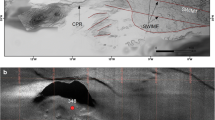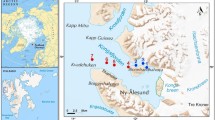Abstract
The community structure of the bathyal meiofauna of a cold-seep community found off Hatsushima in Sagami Bay, central Japan, was compared with the community composition outside the influence of the seep, using sediments collected during dives 226 and 227 of the deep-sea submersibleShinkai 2000. The sediment from the Hatsushima seep site (HSS) was very coarse, black in color, and with an odor of hydrogen sulfide, suggesting reduced thiobiotic conditions. The sediment from the control area was well-oxygenated, fine silt. Despite the differences in the characteristics of the sediments, the abundance of meiofauna in the HSS was not very different from that in the control area. However, its composition even at the major taxonomic group level was distinct; for example, a high nematode/copepod ratio occurred in one of the samples collected at the HSS. At the species level, nematodes were less diverse at the HSS than at the control area. The composition of the nematode fauna at the HSS showed stronger affinity with that collected at the adjacent control area than with a community sampled from other deep-sea environments or another seep community in shallow water. This emphasizes that the adaptation of nematodes to the thiobiotic condition is controlled by local conditions.
Similar content being viewed by others
References
Dinet, A., F. Grassle and V. Tunnicliffe (1988): Premières observations sur la méiofaune des sites hydrothermaux de la dorsale Est-Pacifique (Guaymas, 21°N) et de l'Explorer Ridge. Oceanol. Acta, 1988 special no., 7–14.
Fleeger, J.W., T. Zhican and R.P. Higgins (1983): Preliminary study on the ecology of meiobenthic Copepoda and Kinorhyncha off the Changjiang estuary and adjacent waters. p. 937–946.In: Proceedings of the International Symposium on Sedimentation on the Continental Shelf, with Special Reference to the East China Sea. Vol. II, China Ocean Press, Beijing.
Grassle, J.F. (1986): The ecology of deep-sea hydrothermal vent communities. Adv. Mar. Ecol.,23, 301–362.
Hashimoto, J., S. Ohta, T. Tanaka, H. Hotta, S. Matsuzawa and H. Sakai (1989): Deep-sea communities dominated by the giant clam,Calyptogena soyoae, along the slope foot of Hatsushima Island, Sagami Bay, central Japan. Palaeogeogr. Palaeoclimatol. Palaeoecol.,71, 179–192.
Hessler, R.R. and W.M. Smithey (1984): The distribution and community structure of megafauna at the Galapagos Rift hydrothermal vents. p. 735–770.In: Hydrothermal Processes at Seafloor Spreading Centers, NATO Conference Series, Ser. IV, Marine Science, ed. by P.A. Rona, K. Boström, L. Laubier and K.L. Smith, Jr., Plenum Press, New York.
Jensen, P. (1986): Nematode fauna in the sulfiderich brine seep and adjacent bottoms of the East Flower Garden, NW Gulf of Mexico. IV. Ecological aspects. Mar. Biol.,92, 489–503.
Kimoto, S. (1967): Some quantitative analysis on the chrysomelid fauna of the Ryukyu Archipelago. Esakia,6, 27–54.
Kulm, L.D., E. Suess, J.C. Moore, B. Carson, B.T. Lewis, S.D. Ritger, D.C. Kadco, T.M. Thornburg, R.W. Embley, W.D. Rugh, G.J. Massoth, M.G. Langseth, G.R. Cochrane and R.L. Scamman (1986): Oregon subduction zone: venting fauna, and carbonates. Science,231, 561–566.
Margalef, D.P. (1958): Information theory in ecology. Gen. Syst.,3, 36–71.
Ohta, S. and L. Laubier (1987): Deep biological communities in the subduction zone of Japan from bottom photographs taken duringNautile dives in the Kaiko project. Earth, Planet, Sci. Let.,83, 329–342.
Ohta, S., H. Sakai, A. Taira, K. Ohwada, T. Ishii, M. Maeda, K. Fujioka, T. Saino, K. Kogure, T. Gamo, Y. Shirayama, T. Furuta, T. Ishizuka, K. Endow, T. Sumi, H. Hotta, J. Hashimoto, N. Handa, T. Masuzawa and M. Horikoshi (1987): Report on multidisciplinary investigations of theCalyptogena communities at the Hatsushima site. JAMSTECTR Deepsea Res.,3, 61–68 (in Japanese with English abstract and legends).
Paull, C.K., B. Hecker, R. Commeau, R.P. Freeman-Lynde, C. Neumann, W.P. Corso, S. Golubic, J.E. Hook, E. Sikes and J. Curray (1984): Biological communities at the Florida Escarpment resemble hydrothermal vent taxa. Science,226, 965–967.
Reise, K. and P. Ax (1979): A meiofauna “thiobios” limited to the anaerobic sulfide system of marine sand does not exist. Mar. Biol.,54, 225–237.
Sakai, H., T. Gamo, K. Endow, J. Ishibashi, T. Ishizuka, F. Yanagisawa, M. Kusakabe, T. Akagi, G. Igarashi and S. Ohta (1987): Geochemical study on the bathyal seep communities at the Hatsushima site, Sagami Bay, central Japan. Geochem. J.,21, 227–236.
Shaw, K.M., P.J.D. Lambshead and H.M. Platt (1983): Detection of pollution-induced disturbance in marine benthic assemblages with special reference to nematodes. Mar. Ecol. Prog. Ser.,11, 195–202.
Shirayama, Y. (1987): Ecological studies of meiobenthos inCalyptogena dominant community developing off Hatsushima, central Japan. JAMSTECTR Deepsea Res.,3, 69–73 (in Japanese with English abstract and legends).
Shirayama, Y. (1988): Features of the responses of the meiobenthic community to high organic-matter debt. p. 91–94.In: Biological Monitoring of Environmental Pollution, ed. by M. Yasuno and B.A. Whitton, Tokai University Press, Tokyo.
Suess, E., B. Carson, S. Ritger, J.C. Moore, L.D. Kulm and G.R. Cochrane (1985): Biological communities at a vent site along the subduction zone off Oregon. Bull. Biol. Soc. Washington,6, 475–484.
Warwick, R.M. (1981): The nematode/copepod ratio and its use in pollution ecology. Mar. Pollut. Bull.,12, 329–333.
Author information
Authors and Affiliations
Rights and permissions
About this article
Cite this article
Shirayama, Y., Ohta, S. Meiofauna in a cold-seep community off Hatsushima, central Japan. Journal of the Oceanographical Society of Japan 46, 118–124 (1990). https://doi.org/10.1007/BF02123438
Received:
Revised:
Accepted:
Issue Date:
DOI: https://doi.org/10.1007/BF02123438




